collaboration for better health - Health Sciences - Curtin University
collaboration for better health - Health Sciences - Curtin University
collaboration for better health - Health Sciences - Curtin University
- No tags were found...
Create successful ePaper yourself
Turn your PDF publications into a flip-book with our unique Google optimized e-Paper software.
PROGRAM & ABSTRACTSCOLLABORATION FOR BETTER HEALTHFACULTY OF HEALTH SCIENCESHEALTH INTERPROFESSIONAL EDUCATION CONFERENCE1 October 2010—Bentley Campus
HIPECOLLABORATION FOR BETTER HEALTHhttp://<strong>health</strong>sciences.curtin.edu.au/faculty/ipe.cfmProgram & AbstractsContents 1Welcome 2IPE Initiatives @ <strong>Curtin</strong> 3-4Plenary Address 5Program 6Abstracts 7-15Posters 16Award <strong>for</strong> Best Presentation 16Venue Map & Acknowledgements 17Subtitle: <strong>Health</strong> Interprofessional EducationStudent Conference, Program & AbstractsPublication Date: 09/2010Subject: <strong>Health</strong>ISBN: [978-0-646-53632-3]© 2010 <strong>Curtin</strong> <strong>University</strong> of TechnologyPrinted by Scott Print<strong>Curtin</strong> <strong>University</strong> is a trademark of <strong>Curtin</strong> <strong>University</strong> of TechnologyHIPE 2010: Collaboration <strong>for</strong> Better <strong>Health</strong> (<strong>Health</strong> Interprofessional Education Conference ) 1
WelcomeWelcome to HIPE 2010, the Faculty of <strong>Health</strong> <strong>Sciences</strong>’ Interprofessional EducationConference.Interprofessional Education (IPE) is one of the key initiatives of the Faculty of <strong>Health</strong><strong>Sciences</strong>, enabling <strong>health</strong> professionals to learn with, from, and about each other. Thisconference gives participants the opportunity to share their knowledge and skills whilegaining a deeper understanding of the contribution that each <strong>health</strong> discipline makes tothe care of the client.Evidence of the benefits of IPE has been reported around the world, specifically its role inthe improvement in the safety and quality of <strong>health</strong> care delivery.<strong>Curtin</strong> <strong>University</strong> sees the development of IPE as key to its mission as it will facilitate thechanges needed in <strong>health</strong> professionals and <strong>health</strong> care practice in the future.The focus of this conference is on preparing students to work collaboratively in <strong>health</strong> careteams by providing the context <strong>for</strong> IPE developments internationally and locally andexamples of IPE initiatives we have developed and implemented in the <strong>University</strong>.We trust the presentations will be thought provoking and inspire students to engage infuture interprofessional experiences and facilitate collaborate working which focuses on aholistic view of the patient and the quality of care received.Professor Jill DowniePro Vice-ChancellorPhD, RN, RM, BAppSC (Nursing),PGDipHlthProm, FRCNAHIPE 2010: Collaboration <strong>for</strong> Better <strong>Health</strong> (<strong>Health</strong> Interprofessional Education Conference ) 2
Interprofessional Initiatives @ <strong>Curtin</strong>EducationHCTC—<strong>Curtin</strong> held its second <strong>Health</strong> Care Team Challenge in August involving three interprofessional teams of<strong>health</strong> science students competing in front of expert judges and a live audience to present an integrated careplan <strong>for</strong> a patient with complex medical issues. The winning team then travelled to Brisbane, in September, tocompete against teams from a number of other Australian universities. The team (from nursing, speechpathology, pharmacy, occupational therapy and physiotherapy) per<strong>for</strong>med very well and finished in the top three.HIPE—The Faculty of <strong>Health</strong> <strong>Sciences</strong>’ annual IPE conference is a unique opportunity to hear aboutinterprofessional learning experiences in university, research and fieldwork/clinical settings. Presented andattended by students, staff and industry partners, participants hear how IPE experiences have enriched the<strong>health</strong>care journey <strong>for</strong> the presenters and their clients.Country Week—In <strong>collaboration</strong> with the Combined Universities Centre <strong>for</strong> Rural <strong>Health</strong>, <strong>Curtin</strong> staff andstudents have participated in remote and Indigenous experiences, gaining greater insight into the <strong>health</strong> andsocial concerns of country residents and <strong>health</strong> workers.Workshops—A number of student interprofessional education workshops have been conducted on campussince 2008. Topics have included analysis of clinical errors, communicating with patients, care of strokesurvivors, diabetes management, management of patients with swallowing problems, dementia care, andpalliative care. Staff and industry partners have also participated in Teaching on the Run workshops which willassist them to develop skills in teaching interprofessional learners. A number case studies utilising standardisedpatients are being developed <strong>for</strong> use in a range of learning scenarios.PracticeA number of interprofessional fieldwork/clinical placements have been conducted including:Go Global which provides <strong>Health</strong> <strong>Sciences</strong> students an opportunity to engage in international interprofessionallearning placements in China, Ukraine, India and South Africa;Brightwater Care Group which provides students from a number of disciplines with an opportunity to work in aninterprofessional team in residential and home care settings;Royal Perth Hospital’s Student Training Ward, a first in the southern hemisphere, piloted in September 2010,engages <strong>Curtin</strong> students from physiotherapy, occupational therapy, nursing, social work, and pharmacy (andUWA medical students) in two-week placements. The focus is on applying interprofessional education principlesto the delivery of holistic patient care with an emphasis on teamwork during patient contact, handover, anddischarge planning;<strong>Curtin</strong>’s Activity, Food and Attitudes Program which provides students from physiotherapy, psychology,social work and dietetics with an opportunity to provide an interprofessional service <strong>for</strong> adolescents with obesityand their families;CHIRI IPE Centre will provide interprofessional placements in the areas of obesity, chronic pain, mental <strong>health</strong>,wound care, COPD, diabetes and early intervention services in both on and off-campus facilities. Three pilotsare underway during semester two 2010, in Building 404, with the other services to follow soon after.HIPE 2010: Collaboration <strong>for</strong> Better <strong>Health</strong> (<strong>Health</strong> Interprofessional Education Conference ) 3
Interprofessional Initiatives @ <strong>Curtin</strong> (Continued)ResearchA strong research framework has been developed around IPE initiatives. All case-based learning workshopsand fieldwork placements have been evaluated and staff have received awards <strong>for</strong> their presentations andposters at national and international conferences.International CollaborationsProfessor Dawn Forman (Vice-President, CAIPE) has continued her appointment as Adjunct Professor in theFaculty. Professor Forman’s key activities in 2010 have been around embedding IPE into the curriculum,mentoring staff with research and publication activities and providing guidance to staff around the new 1 st YearCurriculum.Emeritus Professor Hugh Barr visited <strong>Curtin</strong> in April to provide guidance to <strong>Curtin</strong> staff, students and industrypartners.Professor Jill Thistlethwaite, Director of the Institute of Clinical Education at Warwick Medical School andPresident of InterEd, has also visited <strong>Curtin</strong> to attend discussions in relation to the Medical School initiative.Communication<strong>Curtin</strong> provides staff, students and the community with in<strong>for</strong>mation relevant to interprofessional education andcollaborative practice via both its website http://<strong>health</strong>sciences.curtin.edu.au/faculty/ipe.cfm and LMSBlackboard sites. These include a wide range of in<strong>for</strong>mation about IPE; archived lectures and seminars,examples of IPE e-learning, news and events locally, nationally and internationally, an e-reserve reference list,learning materials and research as well as links to other agencies involved in IPE.New in 2010 is pIPEline, a newsletter which assists to keep staff abreast of IPE activities and initiatives.HIPE 2010: Collaboration <strong>for</strong> Better <strong>Health</strong> (<strong>Health</strong> Interprofessional Education Conference ) 4
Plenary AddressDr. Simon C B TOWLERMBBS, FANZCA, FCICM, FAMAChief Medical Officer, Western Australia Department of <strong>Health</strong>Staff specialist in intensive care – Critical Care Institute of WADr Simon Towler, the Chief Medical Officer was appointed in 2005 and continues topractice as an intensivist at Royal Perth Hospital, St John of God hospital and theMount Hospital.Dr Towler’s commitment and passion <strong>for</strong> <strong>health</strong> re<strong>for</strong>m is focused on the provision ofintegrated patient care through mechanisms such as <strong>Health</strong> Networks; disease-specificModels of Care; patient blood management; the rational introduction of medicaltechnologies and IT re<strong>for</strong>m. He is responsible <strong>for</strong> the State Cancer Plan, ResearchTranslation Projects and Reproductive Technology legislation and involved in <strong>health</strong>policy development through the <strong>Health</strong> Networks Branch.He is a member of the Clinical Technical and Ethics Principal Committee of AHMAC;Chair of the National Advanced Care Directives Working Group; advisor to the National<strong>Health</strong> Hospital Re<strong>for</strong>m Commission; and past president of the AMA (WA Branch) andcurrent member of the Medical Board of Western Australia.As Chief Medical Officer, he continues to redress the dichotomies between WAlegislation and medicine and has played a role in developing recent legislation aroundplanning <strong>for</strong> end of life care.HIPE 2010: Collaboration <strong>for</strong> Better <strong>Health</strong> (<strong>Health</strong> Interprofessional Education Conference ) 5
Program — 1 October 2010HIPECOLLABORATION FOR BETTER HEALTHVenue 405-201 : Haydn Williams LT0915-1000 Registration (Foyer)1000-1010 Opening address- Professor Lorna Rosenwax, Deputy PVC, Faculty of <strong>Health</strong> <strong>Sciences</strong>1010-1050 Plenary address-Dr Simon Towler, Chief Medical Officer, WAVenues 405-201 : Haydn Williams LT 405-204 405-2061100-1120 Exploration of the managementof stroke and depression by aninterprofessional team: Aninteractive workshop – Brewer& <strong>Health</strong> <strong>Sciences</strong> studentteams“Seeing things differently”: Areflection on Sydney’sinterprofessional conference -Williams & Binder.1130-1150 Social work and the multidisciplinaryresearch team: A case study -StewartIPE <strong>for</strong> Allied <strong>Health</strong> Students:The Sir Charles GairdnerHospital Experience - Dunkin,Hall & Brookes.Input + Output = Dietetics andPhysiotherapist Integratedapproach to incontinencemanagement - Sivakumar &Croker.1200-1220 Opportunities and challenges increating an environment <strong>for</strong>integrated care - HornerInterprofessional Education StudentPlacements in a Brain InjuryRehabilitation Programme –Coates,P<strong>for</strong>r & TeapeChallenging mealtimebehaviours: working withDementia: An IPE approach -Hall & CheeVenues 405-201 : Haydn Williams LT1230-1315 Lunch with Poster Display (Foyer)1320-1400 <strong>Health</strong> Care Team Challenge: Reflections on the <strong>Curtin</strong> & National competitions – Hall, Mather, Williams,Robert, Ihdayhid, KeesingVenues 405-201 : Haydn Williams LT 405-204 405-2061400-1420 Interprofessional education inthe first year core curriculum -Jones & LawsonDudley: A man <strong>for</strong> all professions -Tulloch, Ng Cheong Tin, Donaldson,Moss, Irving & KeatonStudent reflections on a remoteIndigenous interprofessionaleducation experience in countryWA: Country Week – Butler, Ip& Taylor1430-1450 Interprofessional education and<strong>collaboration</strong> in curriculumdevelopment: Perspectivesfrom <strong>Curtin</strong>’s Faculty of <strong>Health</strong><strong>Sciences</strong> staff - Davis, Brewer& Jones1500-1520 An innovative approach toclinical training: The firststudent led ward in the southernhemisphere – Brewer, Franklin,Stewart-Wynne, Demos, Da Re,Smith, Fussell, McGillivray,JakimowiczWhat’s all the buzz about? IPEinsights from a pharmacist, nurse,occupational therapist and socialworker – Barns, Donaldson, Keesing& Ng Cheong TinThe Virtual Wound Clinic: Towardsthe future in augmenting cliniceducation - Watts, Irving &DonaldsonUsing on-line learning to fosterinterprofessional <strong>health</strong>education: A dementia casestudy - Franklin, Cartwright,Gillieatt & IrvingVenue 405-201 : Haydn Williams LT1530-1550 Student keynote “The future of <strong>health</strong> is one that we are creating” - Banks, Falconer, Ivey, Jeyabalan, Ludin1550-1600 Closing address, evaluations, awards and prizesHIPE 2010: Collaboration <strong>for</strong> Better <strong>Health</strong> (<strong>Health</strong> Interprofessional Education Conference ) 6
AbstractsAn innovative approach to clinical training: The first student led ward in the southern hemisphere.Margo Brewer 1 , Diane Franklin 1 , Ted Stewart-Wynne 2 , Doreen Demos 2 , Claire-Louise Da Re 2 , Peter Smith 2 ,Amy Fussell, (occupational therapy student), David McGillivray (social work student), Wladimir Jakimowicz(nursing student)1 Faculty of <strong>Health</strong> <strong>Sciences</strong>, <strong>Curtin</strong> <strong>University</strong>, <strong>Curtin</strong> <strong>Health</strong> Innovation Research Institute2 Royal Perth Hospitalm.brewer@curtin.edu,au, d.franklin@curtin.edu.au, Edward.Stewart-Wynne@<strong>health</strong>.wa.gov.au,Doreen.Demos@<strong>health</strong>.wa.gov.au, Claire-Louise.DaRe@<strong>health</strong>.wa.gov.au, peter.k.smith@<strong>health</strong>.wa.gov.auamy.fussell@student.curtin.edu.au, david.mcgillivray@student.curtin.edu.auwladimir.jakimowicz@student.curtin.edu.auInterprofessional education has been utilised <strong>for</strong> many years as an effective method <strong>for</strong> improving <strong>collaboration</strong>between <strong>health</strong> professions with the ultimate aim of improving client/patient outcomes. The World <strong>Health</strong>Organisation has been encouraging both interprofessional education and collaborative practice with their reports“Learning together to work together <strong>for</strong> <strong>health</strong>” (1988), “Working Together <strong>for</strong> <strong>Health</strong>” (2006) and their“Framework <strong>for</strong> Action on Interprofessional Education and Collaborative Practice “ (2010).Over the past two years <strong>Curtin</strong> <strong>University</strong> has established an international reputation <strong>for</strong> providing authenticinterprofessional placements <strong>for</strong> <strong>health</strong> science students in a range of settings. One key placement initiative isthe Student Training Ward developed in <strong>collaboration</strong> with Royal Perth Hospital (RPH). This initiative began with<strong>Curtin</strong> and Royal Perth Hospital staff visiting existing training wards to learn from best practice internationally.Policies and procedures were developed by <strong>Curtin</strong> and RPH which would ensure staff and students experiencea ward where students learn “with, from and about” each other whilst providing safe, high quality care <strong>for</strong> thepatients.The pilot placements commenced in semester two this year with final year students from <strong>Curtin</strong>’s nursing,pharmacy, physiotherapy, occupational therapy, and social work programs being joined by medical studentsfrom the <strong>University</strong> of Western Australia. A brief history of training wards along with an overview of the ward atRPH will be provided. The key focus of the presentation however will be participants’ reflections on the benefitsof this innovative approach to clinical training <strong>for</strong> students, staff, and most importantly patients.Challenging mealtime behaviours: working with Dementia: an IPE approach.Jason Hall (Masters of Speech Pathology), Derserri Chee (Bachelor of Occupational Therapy)Faculty of <strong>Health</strong> <strong>Sciences</strong>, <strong>Curtin</strong> <strong>University</strong>jason.hall@postgrad.curtin.edu.au, y.chee@student.curtin.edu.auDementia is “a condition of acquired, progressive degeneration of intellectual disabilities affects several cognitivedomains such as language, memory, visual spatial skills, emotion or personality and executive functions such asreasoning or abstraction” (Chapey, 2001, p. 70).Currently in Western Australia, aged care facilities cater <strong>for</strong> people with dementia who exhibit challenging mealtimebehaviours. <strong>Health</strong> care professionals at Brightwater a residential/ transitional aged care facility, reportedthat clients with dementia demonstrate challenging mealtime behaviors. This indicated a need <strong>for</strong> theimplementation of practical staff education in the management of challenging mealtime behaviours. A pre-poststudy conducted on 5 staff members evaluated the effectiveness of practical mealtime management atBrightwater Kingsley with direct input from speech pathology and occupational therapy.The effectiveness of the project was rated using a likert scale questionnaire based on staff members’ perceivedusefulness and practicality of the interventions. The project received a significant positive response. Furtherimplementation of this project on a larger sample size will be needed to confirm the effectiveness of aninterprofessional approach within this setting.HIPE 2010: Collaboration <strong>for</strong> Better <strong>Health</strong> (<strong>Health</strong> Interprofessional Education Conference ) 7
AbstractsDudley: A man <strong>for</strong> all professions.Alan Tulloch, Pascale Ng Cheong Tin, Michelle Donaldson, Penny Moss, Leah Irving, Juliet KeatonFaculty of <strong>Health</strong> <strong>Sciences</strong>, <strong>Curtin</strong> <strong>University</strong>, <strong>Curtin</strong> <strong>Health</strong> Innovation Research Institutea.tulloch@curtin.edu.au, pascale.ng@curtin.edu.au, m.donaldson@curtin.edu.au, p.moss@curtin.edu.au,l.irving@curtin.edu.au. j.keaton@curtin.edu.auAcademics from Pharmacy, Nursing, and Physiotherapy worked together on a project to develop visual learningresources <strong>for</strong> the clinical schools within the Faculty of <strong>Health</strong> <strong>Sciences</strong>.Through collaborative teamwork, thoughts and ideas have culminated in the creation and development of aunique, on-line, interprofessional learning experience. With the creative use of video footage, the centralcharacter of the case study, Dudley, emerges as a multifaceted persona to engage students in exploring thedifferent aspects of his world and to develop an understanding of how he interacts with his community and thestrategies he uses to maintain his wellbeing.Through the flexible use of Blackboard® and a range of technologies, students from different professions willcollaborate on-line to identify local community resources and the major threats and risks to Dudley’sindependence. In this presentation, team members will share their thoughts and experiences on the rewards ofcollaborative practice through the IPE process.Exploration of the management of stroke and depression by an interprofessional team: Aninteractive workshop.Margo Brewer & <strong>Health</strong> <strong>Sciences</strong> student teamsFaculty of <strong>Health</strong> <strong>Sciences</strong>, <strong>Curtin</strong> <strong>University</strong>, <strong>Curtin</strong> <strong>Health</strong> Innovation Research Institutem.brewer@curtin.edu.auThe Faculty of <strong>Health</strong> <strong>Sciences</strong> at <strong>Curtin</strong> <strong>University</strong> is committed to preparing our students to meet not only the<strong>University</strong>’s graduate attributes but also all three elements of the triple i curriculum: industry ready withinterprofessional and intercultural capabilities. One critical element to meeting this goal was the introduction of arange of interprofessional education workshops which are facilitated by interprofessional teams of staff.This presentation focuses on the largest scale of these workshops which has involved students from medicine,nursing, pharmacy, physiotherapy, occupational therapy, speech pathology, social work, psychology, medicalimaging, laboratory medicine, dietetics and others from public <strong>health</strong> working together to develop a care plan <strong>for</strong>a hypothetical client who has a stroke and develops depression.The students who have participated over the past two years have reported an increased understanding of theroles, responsibilities, and competence of each profession as well as the skills required to work together todevelop an integrated care plan <strong>for</strong> the client. In this session, participants will have the chance to discuss issuesin small groups and to view the final care plans of the interprofessional student teams who participated in theworkshop this semester and were judged by a panel of staff to have developed the best plan.These winning students will also share their reflections on this experience and what they have gained that willassist them not only in their future practice but also in applying <strong>for</strong> jobs at the end of this year.HIPE 2010: Collaboration <strong>for</strong> Better <strong>Health</strong> (<strong>Health</strong> Interprofessional Education Conference ) 8
AbstractsThe future of <strong>health</strong> is one that we are creating.Gerda Banks (Social Work), Lauren Falconer (Occupational Therapy), Kerry Ivey (Dietetics), Avinash Jeyabalan(Physiotherapy), Amy Ludin (Speech Pathology)Faculty of <strong>Health</strong> <strong>Sciences</strong>, <strong>Curtin</strong> <strong>University</strong>gerritje.banks@student.curtin.edu.au, lauren.falconer@student.curtin.edu.au, kerry.ivey@gmail.com,avinash.jayabalan@student.curtin.edu.au, amy.ludin@student.curtin.edu.auInterprofessional education is seen by many as an important component of curricular re<strong>for</strong>m in the education of<strong>health</strong> professionals. To create and sustain any such educational re<strong>for</strong>m requires acknowledgement of the roleof students as not only the work<strong>for</strong>ce of the future but also as powerful change agents. Our students willpractice in ways that we have not envisaged with new models of care and new approaches to <strong>health</strong> servicesand <strong>health</strong> care.We invite you to join a group of student champions from social work, physiotherapy, occupational therapy,speech pathology and dietetics as they explore their vision <strong>for</strong> the future of <strong>health</strong> and the preparation of thoseinvolved in its delivery. These students will engage, challenge and inspire us all to Collaborate <strong>for</strong> Better <strong>Health</strong>.<strong>Health</strong> Care Team Challenge: Reflections on the <strong>Curtin</strong> and the National competitions.Jay Hall (speech pathology student), Kendall Mather (nursing student), Caitlin Williams (physiotherapy student),Nora Ihdayhid (pharmacy student), Yvette Robert (occupational therapy student) & Sharon Keesing (staffmentor)Faculty of <strong>Health</strong> <strong>Sciences</strong>, <strong>Curtin</strong> <strong>University</strong>jason.hall@postgrad.curtin.edu.au, kendall.mather@student.curtin.edu.au,caitlin.williams@postgrad.curtin.edu.au, nora.ihdayhid@student.curtin.edu.au,yvette.Robert@student.curtin.edu.au, s.keesing@curtin.edu.auThe HCTC is an extracurricular competition <strong>for</strong> final year students from the Faculty of <strong>Health</strong> <strong>Sciences</strong> at <strong>Curtin</strong><strong>University</strong>. It provides students with an opportunity to demonstrate their expertise in teamwork and <strong>collaboration</strong>as they develop a management plan <strong>for</strong> a client with complex <strong>health</strong> needs. Pioneered by academics from the<strong>University</strong> of British Columbia over 20 years ago it was adapted by both the <strong>University</strong> of Queensland and <strong>Curtin</strong><strong>University</strong>. Students work in a team of 4 to 6 students from across the <strong>health</strong> professions at <strong>Curtin</strong> to prepareand present responses to a complex clinical case in the <strong>for</strong>m of a care plan. Each team then presents a plan to apanel of expert judges in front of a live audience.The presentation will feature members of the team that won the <strong>Curtin</strong> challenge held in August this year whotravelled to Queensland to complete against teams from several other Australian universities. The students willshare their journey from <strong>for</strong>mation of their team, through the <strong>Curtin</strong> and then national events.They will highlight what they have gained both personally and professionally from participating in the HCTC.Their staff mentor will also share her perspective on this engaging and rewarding interprofessional educationexperience.HIPE 2010: Collaboration <strong>for</strong> Better <strong>Health</strong> (<strong>Health</strong> Interprofessional Education Conference ) 9
AbstractsInput + Output = Dietetics and Physiotherapist - Integrated approach to incontinencemanagement.Pushparani Sivakumar (Dietician); Nerida Croker (Senior Occupational Therapist)King Edward Memorial Hospital, WApushparani.sivakumar@<strong>health</strong>.wa.gov.au, nerida.croker@<strong>health</strong>.wa.gov.auAt King Edward Memorial Hospital (Western Australia’s only tertiary Women and Newborn Hospital), InterProfessional Learning (IPL) was initiated in 2009 as part of the clinical placement <strong>for</strong> students. It was a valuableand first time experience <strong>for</strong> the students and supervisors. IPL helped to identify the scope of shared anddifferent competencies among the two Allied <strong>Health</strong> disciplines involved.Dietetic and Physiotherapy supervisors together recognised an IPL opportunity <strong>for</strong> shared case management ofa Physiotherapy outpatient client with urinary incontinence. This patient was also referred to Dietetics <strong>for</strong> weightreduction. Patient details were given to both the students, who identified the clinical issues and common goals<strong>for</strong> the care plan. Students presented the management of this case from an Interprofessional perspective to staffof both disciplines.The success of this initiative showed that IPL at placement is an excellent opportunity <strong>for</strong> the students tograduate as an emerging work<strong>for</strong>ce with good multidisciplinary skills and knowledge.Improved patient care is the prime focus of IPL and the student, supervisor and client experience of thisenhanced case management will be presented.This new initiative has the potential to be implemented at KEMH across a range of disciplines and settings inorder to deliver the best care <strong>for</strong> clients. These opportunities <strong>for</strong> Interprofessional learning, education andpractice are waiting to be explored.Interprofessional education and <strong>collaboration</strong> in curriculum development: Perspectives from<strong>Curtin</strong>’s Faculty of <strong>Health</strong> <strong>Sciences</strong> staff.Melissa Davis, Margo Brewer, Sue JonesFaculty of <strong>Health</strong> <strong>Sciences</strong>, <strong>Curtin</strong> <strong>University</strong>, <strong>Curtin</strong> <strong>Health</strong> Innovation Research Institutem.davis@curtin.edu.au, m.brewer@curtin.edu.au, sue.jones@curtin.edu.auThe Faculty of <strong>Health</strong> <strong>Sciences</strong> at <strong>Curtin</strong> <strong>University</strong> has committed to implementing a Common Core Curriculum<strong>for</strong> all first year students from 2011. The ‘common’ elements of this curriculum model entail a set of five ‘core’units that every student in the Faculty will study, and eight ‘specific option’ units that groups of students willstudy based on their course.The new Curriculum is being designed to enhance the core competencies of <strong>health</strong> science students and topromote interprofessional learning. Teams of staff from Schools across the Faculty are currently involved in thedevelopment of the ‘common core’ and ‘specific option’ units. This process is providing staff with richinterprofessional experiences.Staff who are and are not members of the unit development teams were invited to complete a survey about theirperceptions of interprofessional relationships and interpersonal interactions, with the aim of evaluating theimpact of working in interprofessional teams on staff attitudes towards interprofessional interactions over thecurriculum development period.This paper reports the findings from 63 Faculty staff who completed the survey at the start of curriculumdevelopment. The findings highlight the perceived benefits and challenges of working in interprofessional teamsand demonstrate important issues <strong>for</strong> consideration in the establishment of interprofessional teaching teams toimplement the new units.HIPE 2010: Collaboration <strong>for</strong> Better <strong>Health</strong> (<strong>Health</strong> Interprofessional Education Conference ) 10
AbstractsInterprofessional education in the first year core curriculum.Sue Jones, Kathy LawsonFaculty of <strong>Health</strong> <strong>Sciences</strong>, <strong>Curtin</strong> <strong>University</strong>, <strong>Curtin</strong> Heath Innovation Research Institutesue.jones@curtin.edu.au, kathryn.lawson@curtin.edu.au<strong>Curtin</strong>’s Faculty of <strong>Health</strong> <strong>Sciences</strong> will implement a common first year <strong>for</strong> all undergraduate courses in 2011.The year will consist of a core of five units that all students will take, along with a choice of option units that havebeen developed with input from at least two schools, and a further two discipline-specific units. The core unitshave been developed by representatives from all schools in the faculty and recognise and stress the importanceof interprofessional <strong>collaboration</strong> which has been borne out in the design process itself.The structure of the first year offers many benefits to the students in the way they learn and begin to developskills in their field of <strong>health</strong>. The benefits include increased flexibility <strong>for</strong> students in terms of changing coursesand specifically an opportunity to be involved in interprofessional education which has been highlighted asimportant <strong>for</strong> graduates of the future. All graduates will develop collaborative practice capabilities to ensure theyare able to deliver high quality, safe services that are client centred (clients are considered to be individuals,families, groups or communities). These require exceptional skills in communication, team function, reflectivepractice, conflict resolution as well as an understanding of the <strong>health</strong> context and their role in it.Each unit is entirely new and being designed by staff representatives from each of the schools involved.Interprofessional education has underpinned the development of the content, learning activities and assessmentwhich make up the core units. It places importance on creating engaging and active learning experiencesinvolving students from all disciplines. Students will learn with, from and about each other to ensure that therange of <strong>health</strong> and social care professional input is considered in designing services that best meet clientneeds.Interprofessional Education Student Placements in a Brain Injury Rehabilitation Programme.Sandy Coats, Mike P<strong>for</strong>r and Kate TeapeBrightwater Oats Streetsandy.coates@brightwatergroup.com, mike.p<strong>for</strong>r@brightwatergroup.comkate.teape@brightwatergroup.com,Brightwater Oats Street is a rehabilitation service that aims to facilitate community integration and maximizeindependent living skills <strong>for</strong> young adults (18-65 years) with an acquired brain injury.Clients may have complex physical, cognitive, social and behavioural issues, requiring a collaborative teamapproach to achieve successful outcomes. Each client has a case coordinator and specific team of professionaland support staff.Recently student placements <strong>for</strong> occupational therapy, physiotherapy, social work, and speech pathology havehad an interprofessional education focus, with students working alongside each other within the framework ofthe Oats Street programme. Students were allocated to set therapy teams and projects as well as participatingin student interprofessional team meetings.The presentation will outline some of the outcomes of the interprofessional education placements <strong>for</strong> the clients,staff and students involved, including:1. Consistent rein<strong>for</strong>cement of client goals resulting in improved goal achievement.2. Enhanced co-ordination of client therapy programmes that had a comprehensive interdisciplinaryfocus.3. Increased knowledge of the roles and skills of different professions.4. Development of team skills including negotiation, flexibility, organisation and time management.5. Awareness of positive effects of this model of service delivery.HIPE 2010: Collaboration <strong>for</strong> Better <strong>Health</strong> (<strong>Health</strong> Interprofessional Education Conference ) 11
AbstractsIPE <strong>for</strong> Allied <strong>Health</strong> Students: The Sir Charles Gairdner Hospital Experience.Elizabeth Dunkin, Lindy Hall, Kim BrookesSir Charles Gairdner Hospitalelizabeth.dunkin@<strong>health</strong>.wa.gov.au, lindy.hall@<strong>health</strong>.wa.gov.au, kim.brookes@<strong>health</strong>.wa.gov.auObjectives: To provide a <strong>for</strong>um <strong>for</strong> Allied <strong>Health</strong> students on practicum at SCGH to gain an understanding of andrespect <strong>for</strong> their future colleagues.Methods: A clinical education representative from Social Work, Speech Pathology, Dietetics, Physiotherapy andOccupational Therapy collaborated to develop an Inter-Professional Education (IPE) program at SCGH. Theprogram consisted of 3 learning modules: Essential Skills and Knowledge of Teamwork, Interactive CaseStudies, and Observations of Clinicians in Practice. Following students' feedback from the pilot program,modifications, such as the addition of socialising time, were introduced. Outcomes were collected using pre andpost surveys along with the Readiness <strong>for</strong> Inter-Professional Learning Scale (RIPLS).Results: Two IPE programs <strong>for</strong> SCGH Allied <strong>Health</strong> students have been completed. Post program measuresshowed 100% of students felt either ‘confident’ or ‘very confident’ regarding respective professional roles, and‘agreed’ or ‘strongly agreed’ that presentations were interesting and relevant, plus clear and easy to understand.Students reported that the program was highly useful and that they would recommend it to others. All RIPLSoutcomes were positive. Scores relating to team work remained consistently high. The areas of <strong>collaboration</strong>,uniqueness of role, professional role, and patient-centeredness all demonstrated increased RIPLS scores.Conclusion: The SCGH IPE program <strong>for</strong> Allied <strong>Health</strong> students has been a valuable addition to their SCGHplacement experience and enhanced their knowledge and respect <strong>for</strong> others’ roles.Opportunities and challenges in creating an environment <strong>for</strong> integrated care.Barbara HornerFaculty of <strong>Health</strong> <strong>Sciences</strong>, <strong>Curtin</strong> <strong>University</strong>, <strong>Curtin</strong> <strong>Health</strong> Innovation Research Instituteb.j.horner@curtin.edu.auCHIRI <strong>Health</strong> and Wellness Centre will provide an authentic practice-based learning environment, supported by<strong>health</strong> practitioners and provide services <strong>for</strong> the wider community. Students will gain clinical experience as theydevelop the knowledge, skills, and attitudes required <strong>for</strong> interprofessional patient-centred collaborative practice.This environment will create a team approach to work<strong>for</strong>ce development and enhance <strong>health</strong> sectororganisational capability, effectiveness and efficiency.Engagement with an individual client will encourage self management. Self management refers to what a persondoes to manage their situation. It requires a partnership between the individual, their families/carers, and <strong>health</strong>professionals so that they can: Know their condition and various investigation and treatment scenarios Negotiate and agree with a plan of care Engage in activities that protect and promote <strong>health</strong> Monitor and manage the symptoms and signs Manage the impact of the condition on physical functioning, emotions and interpersonalrelationships, and Have confidence in their ability to use support services.The Centre will operate as a ‘hub’ and ‘spoke’ model, where the ‘hub’ is located in the CHIRI <strong>Health</strong> & WellnessCentre, in building 404, and the ‘spokes’ are clinical placement locations external to the <strong>University</strong> with clinicalpartners.This presentation will provide insight into both the process and strategies that are required to realise the requiredoutcomes, <strong>for</strong> students, staff, partners, and clients. It will address an authentic practice-based learningenvironment, supported by <strong>health</strong> practitioners to provide services <strong>for</strong> the wider community; clinical experience<strong>for</strong> students to develop the knowledge, skills and attitude required <strong>for</strong> interprofessional patient-centredcollaborative practice; and a team approach to work<strong>for</strong>ce development and enhance <strong>health</strong> sector organisationalcapability, effectiveness and efficiency.HIPE 2010: Collaboration <strong>for</strong> Better <strong>Health</strong> (<strong>Health</strong> Interprofessional Education Conference ) 12
Abstracts“Seeing things differently”: A reflection on Sydney’s interprofessional conference.Caitlin Williams (physiotherapy student) & Elene Binder (pharmacy student)Faculty of <strong>Health</strong> <strong>Sciences</strong>, <strong>Curtin</strong> <strong>University</strong>caitlin.williams@postgrad.curtin.edu.au, elene.binder@student.curtin.edu.auIn April 2009, as <strong>Curtin</strong> <strong>health</strong> student representatives, we attended the “All together <strong>better</strong> <strong>health</strong> conference 5”,in Sydney, along with students, educators and <strong>health</strong> professionals from around the world,. Over five days wediscussed the importance of IPE, implementation of IPE in both the learning and clinical setting, and future goalsto enhance client centered practice. Presentations throughout the conference included keynote speakers,workshops and round table discussions, providing a variety of environments to discuss and engage in variousIPE centered topics.We were very impressed by some of the current IPE initiatives, including student run clinics in two Canadianuniversities, a South African university’s rural collaborative research projects and, in Australia, the <strong>University</strong> ofQueensland’s <strong>Health</strong> Care Team Challenge. It was inspiring to realize the advancements in IPE across theglobe and the future direction of our professions. It also motivated us to return to <strong>Curtin</strong> with new ideas as tohow our university could progress on the current IPE initiatives to build a stronger IPE community. Theconference culminated in the writing of the “Sydney Interprofessional Declaration” (SID), said to “help supportand advance the future of interprofessional collaborative practice globally”.The presentation will cover our experiences and thoughts of what constitutes IPE, the importance of IPE to<strong>health</strong> professionals, current initiatives around the globe, and current initiatives practiced at <strong>Curtin</strong>. We hope toincrease student awareness, motivation and participation towards future <strong>health</strong> practices that focus oninterprofessional <strong>collaboration</strong>.Social work and the multidisciplinary research team: a case study.Cath StewartFaculty of <strong>Health</strong> <strong>Sciences</strong>, <strong>Curtin</strong> <strong>University</strong>catherine.stewart@student.curtin.edu.auThe research team of <strong>Curtin</strong> <strong>University</strong>’s Activity, Food and Attitudes Program (CAFAP), includes facilitatorsfrom the disciplines of physiotherapy, dietetics, psychology, and social work.As a social work honours student I had the opportunity to facilitate two stages of the social work component ofthe CAFAP. My engagement with this interprofessional education experience proved to be significant, not onlyin furthering my understanding of other <strong>health</strong> disciplines, but also in gaining a critically reflective insight to thecapacities of social work itself. Subsequently, my research is focused on both the theoretical and practicalcontribution of social work to the allied <strong>health</strong> research team in addressing the issue of childhood obesity.This paper identifies the processes of specific social work approaches in the intervention and demonstrates thecontextual application in providing qualitative meanings to the CAFAP research. Analysis of the data has beentriangulated through participant observation; interviews with both previous and current facilitators of each of thedisciplines involved in the program; and relevant literature. Ultimately this study examines the significantcontribution that social work makes available to the CAFAP.HIPE 2010: Collaboration <strong>for</strong> Better <strong>Health</strong> (<strong>Health</strong> Interprofessional Education Conference ) 13
AbstractsStudent reflections on a remote Indigenous interprofessional education experience in countryWA - Country Week.Prue Butler (Physiotherapy Student), Carmen Ip (Occupational Therapy Student), Courtney Taylor (<strong>Health</strong>Science Student)Notre Dame, Edith Cowan <strong>University</strong>, <strong>University</strong> of Western Australiapruzy_b@hotmail.com, carmen_ip_@hotmail.com, courtneyamt@gmail.comTo develop interprofessional <strong>collaboration</strong> and understanding of the primary <strong>health</strong> service delivery to remotesettings in Western Australia students need to be involved. In addition, focus must be placed on developingknowledge concerning the complexities of partnerships and isolation, the cultures of rural societies and our roleas allied <strong>health</strong> professionals working in these areas. These were the goals over a one week intensiveinterprofessional education experience via Combined Universities Centre <strong>for</strong> Rural <strong>Health</strong> (Country Week) inCue, a remote location in Western Australia (WA). Students from each <strong>health</strong> discipline, across the fiveuniversities of WA, (<strong>Curtin</strong>, Edith Cowan <strong>University</strong>, Murdoch, Notre Dame <strong>University</strong>, and <strong>University</strong> of WesternAustralia) nominate themselves to their clinical placement coordinator, followed by the strongest applicantsbeing chosen from the selection criteria.A the conclusion of this time there was a clear deeper understanding of people, the complexity of issues andstrengths in rural and remote <strong>health</strong>, Aboriginal culture, working with and the roles of other allied <strong>health</strong>disciplines, and stronger interest in gaining further rural/remote experiences.This paper will explore the experiences of some of the participants of Country Week 2010 in their key reflections,and how this experience will impact on their future careers and its potential <strong>for</strong> future student direction and itsability to aid our <strong>health</strong> care disparities.Using on-line learning to foster interprofessional <strong>health</strong> education: Dementia case study.Diane Franklin, Jade Cartwright, Sue Gillieatt, Leah IrvingFaculty of <strong>Health</strong> <strong>Sciences</strong>, <strong>Curtin</strong> <strong>University</strong>; <strong>Curtin</strong> <strong>Health</strong> Innovation Research Instituted.franklin@curtin.edu.au, j.cartwright@curtin.edu.au, s.gillieatt@curtin.edu.au, l.irving@curtin.edu.auThe ageing demographic in Australia will have a significant impact on work<strong>for</strong>ce planning and development in allprofessions working in many <strong>health</strong> care settings. Providing care to this expanding aged population requires thedevelopment of <strong>health</strong>care providers’ competence in dealing with the often complex issues involved as well assolid collaborative skills.<strong>Health</strong> <strong>Sciences</strong> at <strong>Curtin</strong> <strong>University</strong> also recognises the need to change the way <strong>health</strong> professionals areeducated to prepare them <strong>for</strong> the ever-changing <strong>health</strong> and social demands worldwide. Interprofessionaleducation (IPE) is one of the key strategies which <strong>for</strong>ms the foundation of many Faculty initiatives enabling<strong>health</strong>care students to learn with, from, and about each other, sharing knowledge, skills and attitudes necessary<strong>for</strong> collaborative practice.This presentation will showcase one such initiative, generously supported by the WA Dementia Training StudyCentre and the goodwill of five academic staff members. It is currently being piloted with 126 <strong>health</strong> carestudents from social work, occupational therapy, nursing, speech pathology, and <strong>health</strong> managementin<strong>for</strong>mation.The presentation will conclude with the reflections of two academic staff involved in the development of theDementia IPE case study throughout 2010. These reflections are guided by common issues and themes evidentin the IPE literature such as the constraints and opportunities in negotiating IPE, interprofessionalcommunication, project complexity, and the level of commitment required.HIPE 2010: Collaboration <strong>for</strong> Better <strong>Health</strong> (<strong>Health</strong> Interprofessional Education Conference ) 14
AbstractsReflections on both the positives of the experience and strategies <strong>for</strong> future development projects will bepresented.The Virtual Wound Clinic: Towards the future in augmenting clinic education.Professor Robin Watts, Leah Irving, Michelle DonaldsonFaculty of <strong>Health</strong> <strong>Sciences</strong>, <strong>Curtin</strong> <strong>University</strong>, <strong>Curtin</strong> <strong>Health</strong> Innovation and Research Instituter.watts@curtin.edu.au, l.irving@curtin.edu.au, m.donaldson@curtin.edu.auThe uptake of Virtual Worlds (VWs) in higher education has increased substantially across the globe in just afew short years however this is still an emerging field and projects utilising VWs are predominantly exploratory.Virtual Worlds such as Second Life, which was used in this project, are three-dimensional simulations whereparticipants interact through their online avatar. It is thought that immediacy or sense of “beingthere” (Schroeder, 2002) experienced by participants of Virtual Worlds may enhance role-playing in activities <strong>for</strong>geographically dispersed learners.The Virtual Wound Clinic began as a collaborative project between <strong>Curtin</strong> <strong>University</strong> and Kings College London(KCL) to develop an interprofessional approach to clinical education using Second Life.The challenge of aligning curriculums between two universities from different hemispheres and there<strong>for</strong>esignificantly different timetables proved too difficult at the time however a scaled down pilot with nursing studentsfrom <strong>Curtin</strong> <strong>University</strong> went ahead.This paper provides an overview of the development of the virtual clinic and the learning design,which has aclient-safety focus. It discusses the practical requirements, contingencies and adaption to change required in thedevelopment of such a project. It provides a summary of the pilot and identifies future possibilities <strong>for</strong> aninterprofessional approach to clinical education using the Virtual Wound Clinic.What’s all the buzz about? IPE insights from a pharmacist, nurse, occupational therapist andsocial worker.Angela Barns (Social Work), Michelle Donaldson (Nursing), Sharon Keesing (Occupational Therapy), PascaleNg Cheong Tin (Pharmacy)Faculty of <strong>Health</strong> <strong>Sciences</strong>, <strong>Curtin</strong> <strong>University</strong>, <strong>Curtin</strong> <strong>Health</strong> Innovation Research Institutea.barns@curtin.edu.au, m.donaldson@curtin.edu.au, s.keesing@curtin.edu.au, pascale.ng@curtin.edu.auIf community was the buzz word of the 1990s, interprofessional education (IPE) and its associated <strong>collaboration</strong>has definitely become the buzz word of the 21 st century. Within the broad field of <strong>health</strong> IPE has beenfragmented and its enactment haphazard. Professional competition and the silo-effect in some disciplines,alongside a lack of available resources, have hindered broad-based engagement with IPE.In the move to embed IPE within university <strong>health</strong> sciences the benefits to students as emerging practitionershas become an important selling point. Equally important to promote, though, are the benefits to thecollaborators of IPE events. In this presentation the IPE Palliative Care team of four academic collaborators (oneeach from pharmacy, occupational therapy, social work and nursing), share their reflections on working togetherover a period of five months.These reflections reveal the ways in which individual expectations and professional understandings of IPE werefacilitated through the collaborative working space. The insights gained are important not only in terms ofprofessional development but as part of ‘selling’ IPE to educators / professionals in a context of competingdemands.HIPE 2010: Collaboration <strong>for</strong> Better <strong>Health</strong> (<strong>Health</strong> Interprofessional Education Conference ) 15
PostersCollaborating to Close the Gender Pay Gap: Working with the Australian Services Union toaddress pay inequity in the Social and Community Services sectorLauren Cayoun (social work student)Faculty of <strong>Health</strong> <strong>Sciences</strong>, <strong>Curtin</strong> <strong>University</strong>cayoun@hotmail.comDuring my student placement as a final year social work student, I worked collaboratively with officials of theAustralian Services Union on the Pay Equity Campaign. The campaign aims to address the inequity betweenprivate sector wages and public sector wages in the Social and Community Services sector. Low rates of payare contributing to an overworked, understaffed private sector with low rates of staff retention and comparativelylittle desirability to workers than other sectors. As the sector is staffed primarily by women, it is very much agender issue and aims to set a precedent to other female dominated sectors that have <strong>for</strong> too long suffered theeffects of poor salaries.Services provided by organisations in the sector include drug and alcohol counseling/support, child protection,mental <strong>health</strong> and other areas of <strong>health</strong> provision. As in any industry, part of the responsibility to provide qualityand effective service rests with the workers in the sector. In order to improve the provision of Social andCommunity Services, it stands to reason that workers should be more appropriately remunerated <strong>for</strong> their skillsand expertise.Working with officials of the Australian Services Union was a rewarding and educational experience. The manyopportunities and <strong>for</strong>ums to share ideas, professional networks and professional knowledge resulted inmaximisation of team strengths and skills. Social workers are involved in activism and advocacy and myexperience demonstrated that the profession can richly contribute to trade union practice and more generally,industrial relations re<strong>for</strong>m.A number of other posters will be on display in the Foyer at lunch.Award <strong>for</strong> Best PresentationThe Faculty of <strong>Health</strong> <strong>Sciences</strong> is offering a prize <strong>for</strong> best presentation at the2010 HIPE Conference.The Award <strong>for</strong> Best Presentation is offered to encourage presenters to engage with theaudience and demonstrate good Teaching and Learning practice.Attendees are asked to select the best presentation (one only) from the sessions attended.HIPE 2010: Collaboration <strong>for</strong> Better <strong>Health</strong> (<strong>Health</strong> Interprofessional Education Conference ) 16
Venue MapsParking—Green Zone405-204405-205405-206401-001 & 401-002Hollis 1 & Hollis 2Lecture Theatres405-201Haydn WilliamsLecture TheatreAcknowledgements & SponsorsOrganising CommitteeMargo BrewerMelissa DavisCassandra DohertyDiane FranklinLeah IrvingSue JonesSponsorsWe are grateful to the sponsors of the 2010 HIPE conference <strong>for</strong> their generous support:HIPE 2010: Collaboration <strong>for</strong> Better <strong>Health</strong> (<strong>Health</strong> Interprofessional Education Conference ) 17
Cricos Provider Code 00301J (WA)



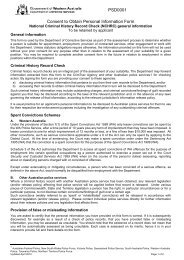
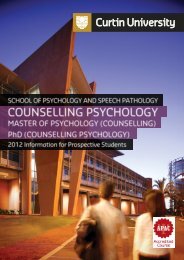
![Mental health commission report July 2010 - June 2011 [.pdf]](https://img.yumpu.com/50755705/1/184x260/mental-health-commission-report-july-2010-june-2011-pdf.jpg?quality=85)
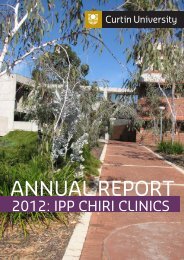
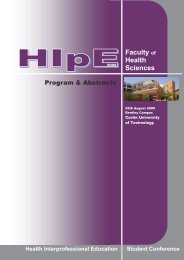

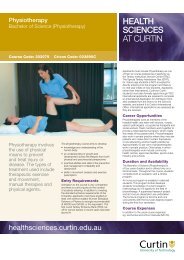
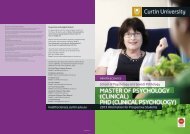
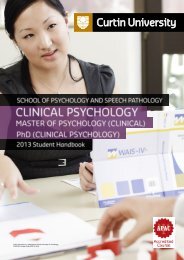

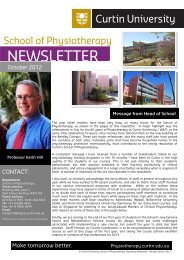
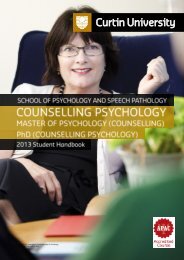
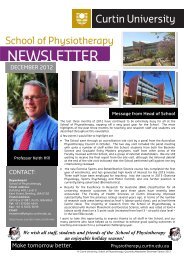
![2007 Annual Report [.pdf] - Health Sciences - Curtin University](https://img.yumpu.com/44476724/1/184x260/2007-annual-report-pdf-health-sciences-curtin-university.jpg?quality=85)